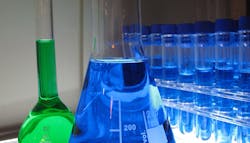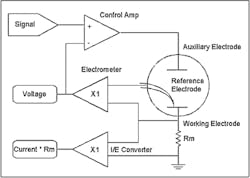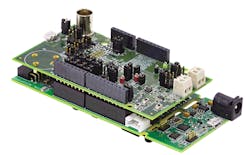Low-Power AFE Tackles Portable Electrochemical Measurements
When compared to “conventional” voltage, current, impedance, power, and spectrum tests spanning dc to RF, the world of wet-lab electrochemistry and its amperometric, voltammetric, and impedance measurements is a very different place with unique challenges and concerns. Still, it’s an important and large niche that’s trending toward lower-power, portable operation, as are so many other T&M settings.
To serve these applications, Analog Devices’ AD5940 is a high-precision, impedance, and electrochemical front end that targets this specialized, yet large and diverse, test-and-measurement world. This analog front end (AFE) comprises many application-focused blocks that are carefully tailored in both their basic function and specifications to the requirements of setting up and making these specialized measurements (Fig. 1).
1. This block diagram of the AD5940 only provides a hint of its internal complexity and functions, as well as the possibilities for the electrochemical tests it directly supports. (Source: Analog Devices)
Among the many types of tests that can be handled by the AD5940 include:
• Electrochemical amperometric measurements, where a bias voltage is applied to a sensor and the response current is monitored.
• Chronoamperometric, or pulse test, in which the voltage across the counter electrode and sense electrode is pulsed, disturbing the normal bias for the electrochemical cell. It’s often but not exclusively used with gas sensors.
• Cyclic voltammetry, where the voltage applied to an electrochemical cell is ramped up and then down in a triangular shape, while the response current on the working electrode is measured. (Note that two- and four-wire voltammetry is also used for impedance measurements on the body, and can measure internal body tissues.)
• Square-wave voltammetry (SWV), where the voltage between the reference and sense electrode is incremented as a square wave and the response current on the working electrode is measured after each half step.
• Electrochemical impedance spectroscopy (EIS), where impedance of the electrochemical cell is measured over a range of frequencies.
The AD5940 includes two high-precision excitation loops plus one common measurement channel. The first excitation loop, which can also generate signals from dc to 200 Hz, includes a dual-output-string digital-to-analog converter (DAC) and a low-noise potentiostat (Fig. 2). The latter is a circuit that controls the voltage difference between a “working” electrode and a “reference” electrode, with both electrodes in an electrochemical cell.
2. A simplified schematic of a potentiostat circuit makes clear it has a very different arrangement compared to the “standard” types of electronic measurements. (Source: Gamry Instruments)
One output of the DAC controls the noninverting input of the potentiostat, and the other output controls the noninverting input of a transimpedance amplifier (TIA). The second excitation loop has a high-speed 12-bit DAC that can generate excitation signals up to 200 kHz.
The device places emphasis on low operating power as well as low quiescent-power modes. An ultra-low-power potentiostat channel results in 6.5 μA of current consumption when powered on and all other blocks in hibernate mode. To minimize test-cycle burden on the host controller, it also includes a programmable sequencer with 6 kB of static RAM.
Using this highly integrated device isn’t trivial due to the inherent nature of the tests. Therefore, Analog Devices prepared two detailed application notes in addition to the datasheet: AN-1557, “Implementing the AD5940 and AD8233 in a Full Bioelectric System” and AN-1563, “Optimizing the AD5940 for Electrochemical Measurements,” plus a general application note on the approach to body-related impedance measurements, “Jack of All Trades in Impedance Measurement.”
Going further, there are two EVAL-AD5940 evaluation boards—a Bio-Electric Evaluation Kit and an Electrochemical Evaluation Board Kit ($300 each) (Fig. 3). Each kit consists of an Arduino form-factor motherboard containing an ADuCM3029 microcontroller that runs sample firmware and communicates with one of two AD5940-based expander boards.
3.The EVAL-AD5940 Evaluation Boards (one for bio-electric measurements, the other for electrochemical applications) include a microcontroller and sample software, in addition to the AFE functions.
The AD5940 operates from a 2.8- to 3.6-V supply and comes in a 3.6- × 4.2-mm, 56-ball, WLCSP package. Since the AFE is designed for use in portable instruments and their harsher environments beyond the lab bench, it’s specified across an operating temperature range of −40 to +85°C. In 1000-piece lots, the ICs are priced at $4.17 each.
About the Author

Bill Schweber
Contributing Editor
Bill Schweber is an electronics engineer who has written three textbooks on electronic communications systems, as well as hundreds of technical articles, opinion columns, and product features. In past roles, he worked as a technical website manager for multiple topic-specific sites for EE Times, as well as both the Executive Editor and Analog Editor at EDN.
At Analog Devices Inc., Bill was in marketing communications (public relations). As a result, he has been on both sides of the technical PR function, presenting company products, stories, and messages to the media and also as the recipient of these.
Prior to the MarCom role at Analog, Bill was associate editor of their respected technical journal and worked in their product marketing and applications engineering groups. Before those roles, he was at Instron Corp., doing hands-on analog- and power-circuit design and systems integration for materials-testing machine controls.
Bill has an MSEE (Univ. of Mass) and BSEE (Columbia Univ.), is a Registered Professional Engineer, and holds an Advanced Class amateur radio license. He has also planned, written, and presented online courses on a variety of engineering topics, including MOSFET basics, ADC selection, and driving LEDs.




